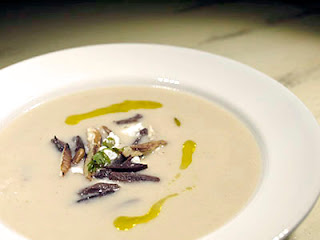Grown-up Mac and Five Cheese
from Vegetarian, Pippa Cuthbert & Lindsay Cameron Wilson, New Holland Publishers, 2010.
You always want a cookbook to give you confidence to go ahead and make a recipe from it, with some sort of assurance that what you make will be close to what you have chosen to make. After I had purchased this book I browsed through it to look at what it contained and my confidence dropped considerably. I was looking at a recipe for Mushroom & Tarragon Wellington and noticed that there were oddly no mushrooms in the list of ingredients. A closer look showed that this was not the recipe that headed the page at all. From the ingredient list I could see that it was items that would make some sort of pasta with broccoli. It did not take too long to find the same recipe under the heading Broccoli, Chilli & Almond Penne. Not a good start. Looks like a poor bit of editing.

Naturally I began to look a little closer—not too much closer—and began to find that this was not the only problem. For example, in one recipe I noticed there is a subheading ‘For the tomato sauce’ in the list of ingredients but you never see where the sauce ingredients end and the other ingredients begin. It looks as though the whole recipe is just the tomato sauce. More editing blunders.
I’d spent my good money purchasing the book so I was determined that I’d give it a go despite the feeling that it might just be better to forget it. So I chose the first recipe in the book, a macaroni cheese. Surely you couldn’t go wrong with that old family favourite. How wrong could I be.
The ingredients list mentions Worcestershire sauce. This is a vegetarian cookbook. Don’t they know that Worcestershire sauce has anchovies in it?
Also the ingredient list says two teaspoons of salt. The first mention of salt in the recipe itself says to add one tablespoon of salt. Later on it actual says to add the remaining salt. I presume that the ingredients list should have been tablespoons, but even if this is the case there is no way I would add one tablespoon of salt to the macaroni cheese with all the salty cheese mixes already in it. Proofreading failure?

Anyway, not to be beaten by a poorly edited book I went ahead with the macaroni cheese, but making substitutions along the way. It turned out to be quite a reasonable dish. I’m not that convinced that all of the different cheeses make that much difference to the flavour. It was a little stronger than you usually find but that doesn’t really make up for the difference in cost to what is basically a family meal. I usually toss in all the bits of cheese left in the fridge and add some Dijon mustard to the mix to add some bite. I did like the addition of sundried tomatoes. They worked well.
Whether I’ll go ahead with making other items from the book remains to be seen. For the moment I’ll put it aside; there’s plenty of other recipe books.
When you find so many errors from a brief look you feel sure that there are going to be more. It all seems a pity because one of the authors is a food journalist and the other a food writer and stylist. To have such an apparently careless piece of publishing attributed to them is not good. My impression is that New Holland Publishers have an editor who is not a cook, or possibly a poor proofreader.
Taste: ✔✔✔
Ease of cooking: ✔✔✔









































